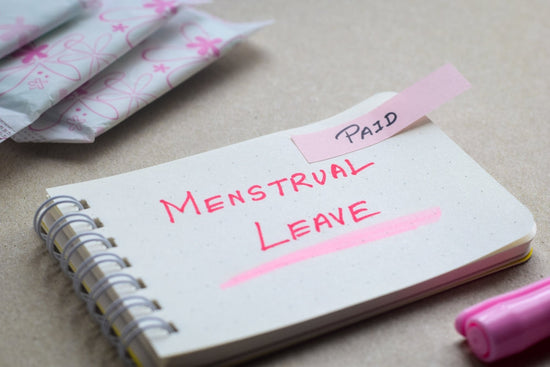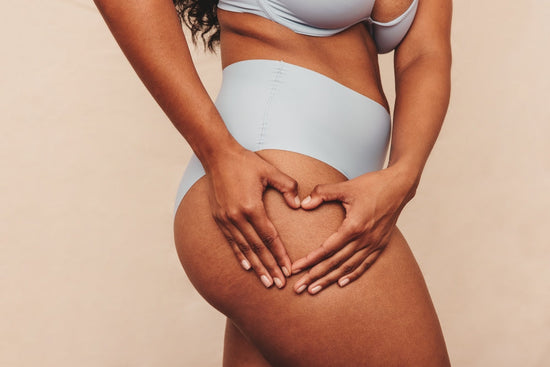Small, large, round, pointed, long... Breasts are different and that's a good thing because they make each person unique. We think that's a way of thinking that we should all follow. But unfortunately, the reality is different. Very few women* are 100% satisfied with their breasts and there is always something wrong with them. It's difficult to accept your own breasts when the media keeps portraying what "perfect" breasts should look like. In today's blog post, we're going to clear up the “Ideal image” and explain to you what breasts can look like and how the breasts can change over the course of the cycle and life.
*The term “woman” in this article refers to persons who are read as female.
Breasts and their anatomy
Let us talk about the anatomy of a woman’s breast. Externally, all female Breasts different, not only in terms of shape, but also the nipples are individual. In addition, there is the areola, i.e. the skin around the nipple, which is more pronounced in one woman and less pronounced in another. This also applies to the so-called Montgomery glands which secrete oil. This keeps the nipple soft and moist. Montgomery glands are the small bumps that are found on the nipple.
As different as the breasts look on the outside, the internal structure is basically the same for all women. The breast is basically made up of glandular tissue and fatty tissue. The glands, also called lobules, are responsible for milk production during pregnancy. This then flows through the milk ducts (ductuli) to the nipple (areola). In addition to mammary glands, the breast also contains nerves, blood vessels and lymph vessels.
Breast tissue begins to develop during the fetus and then stops growing during pregnancy. The fact is that in people who never become pregnant, the breasts never develop fully.
Find the right Taynie for you.Discover our diversity!
Is it normal for one breast to be larger than the other?
Have you ever noticed that your breasts are not the same size? Asymmetrical breasts are completely normal and not uncommon. During puberty, the breasts never develop completely equally. It is often the case that the right breast is slightly larger than the left. Most people are right-handed and the right pectoralis is therefore usually better trained than the left. This means that the right and left breasts can differ in size. And if that is the case with you, rest assured that only you will notice it and that it is absolutely nothing bad.
Is chest hair normal for women?
There is something else about the breast: Even hairs on the areola or on the edge of the breast tissue are completely normal .Did you know that almost one in three women has hair on their chest? Some women only have a few thin hairs on their chest, while others have several thicker hairs on their chest due to genetics.
However, if you notice sudden, excessive hair growth around your nipples or breasts, it could be Hirsutism , i.e. excessive hair growth. This can occur when hormones are out of balance. You should then have the cause clarified by a dermatologist.
Breast shapes
Round breasts
With round breasts, the volume is usually evenly distributed. Accordingly, the breast has the same volume at the top and bottom. With age (and this is completely normal), the breast can lose fullness and size and the breast tissue can become softer. This means that a different breast shape can develop with age.
Bell-shaped breasts
As the name suggests, this breast shape resembles the shape of a bell: the breasts are wider at the bottom and become narrower towards the top. This is usually accompanied by a larger cup size.
Pointy breasts
If the bust size is somewhat smaller, the breasts are often characterized by the fact that they taper more towards the front and the connective tissue is tight.
Teardrop-shaped breasts
Teardrop-shaped breasts are shaped like teardrops or pears. They are narrower towards the cleavage and increase in volume at the bottom. Their widest point is usually at nipple level.
East-West Breasts
Maybe you can already imagine what East-West breasts might look like. Here the nipples or the breasts themselves point outside.
Elongated breasts
Elongated breasts can develop as early as puberty or with age, for example after the birth of a child or after weight loss. The elongated shape is due to the fact that these breasts have less volume and more tissue.
So you can see that breasts and their shapes are very individual. And each shape is beautiful in its own way! In addition, changes in the shape of the breasts may be noticed over the course of a lifetime. So breasts do not necessarily stay with just one shape.
In addition, the phases of your body's cycle can cause your breasts to sometimes have more or sometimes less volume.
When do breasts get bigger during the cycle?
You may have noticed that your breasts change over the course of your cycle - sometimes they are fuller and larger, sometimes softer and a little smaller. Breasts are considered a secondary sexual characteristic and are therefore hormonal In the second half of your cycle, estrogen is released in greater quantities, so that the hormone dominates. This causes more fluid to be stored in the breast tissue. In addition, blood flow to the breasts increases, and they become heavier and larger.
However, breast enlargement during the cycle is often associated with pain. Two out of three women suffer from breast pain during the second half of the cycle. In technical jargon, this is also referred to as mastodynia - one of the many PMS Symptoms.
This means that just wearing a bra often becomes torture and exercising is out of the question. How long this stretching pain lasts varies from person to person. As soon as the estrogen level drops again with the start of the period, the fluid also decreases and the symptoms disappear.
Tip: Monk’s pepper can also help with PMS symptoms. If you want to learn more about this medicinal plant, you should read our Blog post read about it.
The uniqueness of breasts
We can say that breasts are diverse and unique. They come in many shapes, in all sizes and the nipples or areola can also vary from person to person. The fact is that they are all beautiful in their own way and the variety of breast characteristics should be recognized! After all, they are more than just "objects" as they are often portrayed in society. They have important functions that go beyond aesthetics, such as breastfeeding. We should therefore learn to love our bodies as they are and also look for more in everyday life. Self-love care for.
Our appeal: Normalize different types of boobs !
Once this has been established and anchored in people’s minds, it will help at the end of the








